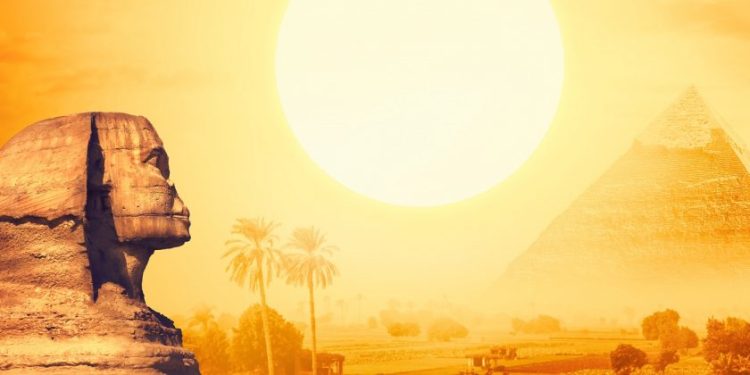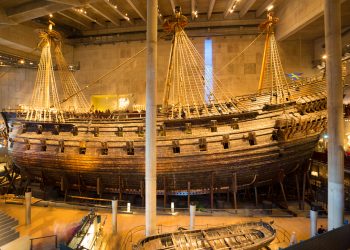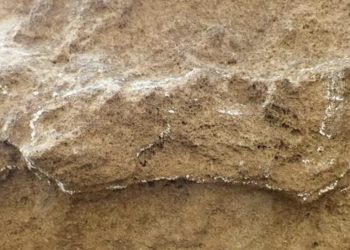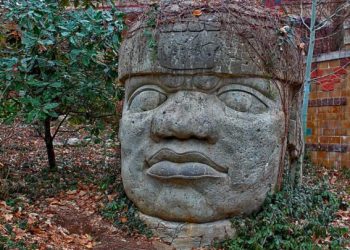Throughout many millennia, the ancient Egyptian sculpted and crafted hundreds of mind-bending statues across the country. Ranging from a few centimeters to dozens of meters in height, the ancient Egyptians deified their rulers as gods through some of these ancient works of art.
But one particular statue stands out from the rest. It’s so unique that no one other statue is reminiscent of it. The Great Sphinx of Giza is a mystery written in stone.
The monument’s body was carved to a scale of 22:1, while its head, the most controversial part of the monument, was carved 30:1.
It was a monument worthy of the greatest pyramids. Mainstream scholars maintain that the great Sphinx, as the statue is known today, was carved some 2,500 years ago, during ancient Egypt’s Fourth Dynasty, under the rule of Pharaoh Khafre, the king who also built the second-largest pyramid at the Giza plateau.
As noted by archeologists Mark Lehner, who maintains the Sphinx was commissioned by Khafre, the project behind the Great Sphinx was so huge in ancient times that the Egyptians would not carve statues of such proportions again until the reigns of the New Kingdom Pharaoh’s like Ramesses II, around 1,200 years after the Sphinx was thought to have been carved by Khafre.
The colossal project involving in carving the Sphinx was unprecedented, evidence of which is the lack of any similar-sized statues with equal or similar age.
The Khafre theory
Unlike other ancient Egyptian statues, the Great Sphinx was carved in-situ, directly from the natural bedrock at what archeologists today say is the base of Khafre’s causeway.
Although the evidence is scarce connecting any Pharaoh from the fourth dynasty with the creation of the Sphinx, let alone Khafre specifically, mainstream scholars remain confident that this was the case. Geologist Thomas Aigner concluded, after analyzing the surroundings of the sphinx and the area where it was carved, that some of the stones of Khafre’s temples are directly connected to the Sphinx.
Aigner argues that the valley temple was most likely made out of the massive blocks of stone that were quarried from the layers that originate from the upper parts of the Sphinx’s body.
Furthermore, geologists concluded that the large core blocks used in the construction of the so-called Sphinx temple were quarried from just below the chest height of the body of the Sphinx.
But what all of that actually means is that the stones used in some of the temples and buildings at Giza originated from the very limestone layers from which the Sphinx was carved. So it is not indicative of direct evidence connecting and perfectly matching the stones to the Sphinx’s body. So, therefore, we can’t say with absolute certainty that the Sphinx was carved when Khafre reigned over Egypt, just because the stones used in some of his temples came from the same area where the Sphinx would have been carved from.
Solar Deities and worship
Another apparent reason why the Sphinx can be traced back to Pharaoh Khafre is connected to the worship of the sun. According to Egyptologists, the lion was identified as a solar symbol in many cultures across Africa and the world and a common archetype of kingship.
In ancient Egypt, the head of a human fused with the body of a lion signified power. So it might be controlled by the intelligence of the Pharaoh, who himself in ancient Egypt was seen as a kind of god, guardian of cosmic order.
Although the worship of the sun has been commonly used as a term for “pagan” religion, it is, in fact, relatively rare. Even though many ancient cultures used solar motifs, only relatively few (Egyptian, Indo-European, and Meso-American) developed actual solar religions.
These ancient civilizations had in common a well-developed urban culture with a strong ideology of sacred kingship. These ancient cultures saw the imagery of the sun as the ruler of both the upper and the lower worlds.
It is argued that in the New Kingdom, the Great Sphinx was identified as a living image of the sun god, and it is possible, say Egyptologists, that precisely that was the statue’s intended design when it was carved in the Fourth Dynasty.
But there is ample evidence that suggests otherwise, pointing to the fact that the Great Sphinx goes further back in time than Egypt’s Fourth Dynasty and even the Age of Pyramids.
A statue that predates Egypt?
The Sphinx’s head is reminiscent of anyone you can picture. We have absolutely no evidence whatsoever that points to the assertion that Khufu’s face was carved onto the Sphinx and that he is the original creator of the statues. For all that we know, the face of the Sphinx may have been carved in the likeness of any Pharaoh predating Khafre. It could be the face of Khufu, that of Thutmose, or even Ramesses, for all we know.
As I have explained in previous articles, almost anyone could have recarved and re-shaped the face of the sphinx in its long history. However, there is evidence of major recarving on the sphinx, the fact that even Egyptologists and archeologists like Mark Lehner have acknowledged.
For all we know, the great Sphinx could have been an entirely different statue, with a different head, shape of the head, and depicted not a human head but that of a god or even animal.
1) The Sphinx’s problem: the head
Lehner has revealed that the head of the Sphinx, compared to its body, is quite disproportionate. According to Lehner, the head of the Sphinx appears too small compared to the body. This is a clearly visible feature that might tell us a lot about the Sphinx.
Lehner acknowledges that the body of the Sphinx is much more elongated than it should be and that the monument has a smaller head and headdress in relation to the body. But he says that we are not faced with a question concerning the recarving of the head or being cut down in size, but rather with a question about the geology of the limestone the statue was carved from.
According to Lehner, the ancient Egyptians who carved the Sphinx encountered a defect in the block of stone that made up the body that would prevent them from finishing off the statue successfully. To solve the problem, Lener argues that the builders elongated the sphinx body to compensate for it.
But while that means the builders made the body bigger, we are still left with the dilemma concerning the size and aesthetics of the Sphinx’s head.
2) Evidence of heavy recarving
There is a possibility that the Sphinx was a much bigger statue in the distant past than presently. Specifically, its head, which is one of the statue’s most mutilated and damaged parts.
Although Lehner proposes in previous writing that the Great Sphinx of Giza is the result of ancient Egyptians experimenting with statue carving, its equally possible that the disproportionate size of the head is the direct result of one to many re-carvings on the face of the Sphinx.
Its head, face, and headdress may have been much larger in size but were ‘trimmed down’ due to too many recarving of the monument that changed and modified its original appearance.
3) Undatable and totally anonymous
The Sphinx is anonymous to its very extent. We don’t know absolutely anything about it. So why have we no scientific evidence that can conclusively tell us when the Sphinx was carved?
We have absolutely no conclusive evidence that tells us anything about the origin of the Sphinx and what the statue looked like when it was completed, either during Khafre’s reign or during times that predate even the ancient Egyptian civilization.
Precisely this lack of that evidence is what led Mark Lehner in 1992 to make two contradictory statements about the Sphinx.
At the annual meeting of the American Association for the Advancement of Science, he said: “There is no direct way to date the Sphinx itself because the Sphinx is carved right out of the natural rock.”
In the Cambridge Archaeological Journal, Mark Lehner explained: “Although we are certain that the Sphinx dates to the Fourth Dynasty, we are confronted by a complete absence of Old Kingdom texts which mention it.”
The first point is common sense. We can’t date the Sphinx based on its composition.
The second point is awkward. Lehner claims with certainty that the Sphinx was carved during the Fourth Dynasty but then says there is no evidence to support it, as there is a “complete absence of Old Kingdom Texts that mention it.”
But rather than the lack of Old Kingdom texts, we are faced with a complete lack of ancient texts that mention the Sphinx, its purpose, or the date it was carved.
We have nothing. Zero. Nada.
Egyptologist Selim Hassan gives us perhaps the best explanation about the Sphinx, caring not about mainstream views on the statues and controversial opinions.
In his 1949 work about the Sphinx, Hassan explains:
Excepting for the mutilated line on the granite stela of Tuthmosis IV, which proves nothing, there is not a single ancient inscription which connects the Sphinx with Khafre. So sound as it may appear, we must treat this evidence as circumstantial until such time as a lucky turn of the spade will reveal to the world definite reference to the erection of this statue…
Hassan’s writing resumes our knowledge about the Sphinx in an excellent way. However, what evidence we have by no means proves anything, and the conclusions made by Egyptologists to this date are inconclusive since they are based upon theories and personal views.
The Sphinx of Giza is so old that the first restoration works were done around the 14th century BC. However, by the time Thutmose IV came to the throne of Egypt, the Sphinx was already badly damaged, heavily deteriorated, buried in sand, and need further restoration.
Three millennia after Thutmose IV, history would see the monument buried again. Further evidence that the Sphinx does not show physical evidence of being carved in the likeness of Khafre is presented by French Egyptologist Gaston Maspero surveyed the Sphinx in the 1920s and revealed that: “The Sphinx stela shows, in line thirteen, the cartouche of Khephren. I believe that to indicate an excavation carried out by that prince, following which, the almost certain proof that the Sphinx was already buried in sand by the time of Khafre and his predecessors.”
Join the discussion and participate in awesome giveaways in our mobile Telegram group. Join Curiosmos on Telegram Today. t.me/Curiosmos











